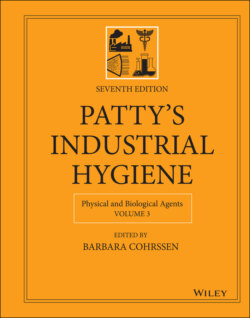Читать книгу Patty's Industrial Hygiene, Physical and Biological Agents - Группа авторов - Страница 114
4.1.2.2 Aphakic Hazard
ОглавлениеThe natural lens of the eye is highly UV‐absorbing, and together with the cornea serves to shield the retina from UV radiation. Aphakia, the absence of a lens, is a rare condition that may be a result of cataract surgery or a congenital defect. If the natural lens is not replaced with a UV‐absorbing artificial lens, harmful levels of UV may reach the retina and cause photochemical damage. The ACGIH has established a TLV for exposure of people with aphakia to radiation in the range 305–700 nm (20). The exposure limits for the aphakic hazard are the same as for the blue‐light hazard, except that the source radiance (or the irradiance at the eye, in the case of a small source subtending less than 11 mrad) is spectrally weighted by the aphakic hazard function A(λ) instead of the blue‐light hazard function B(λ). A(λ) is plotted in Figure 9.
